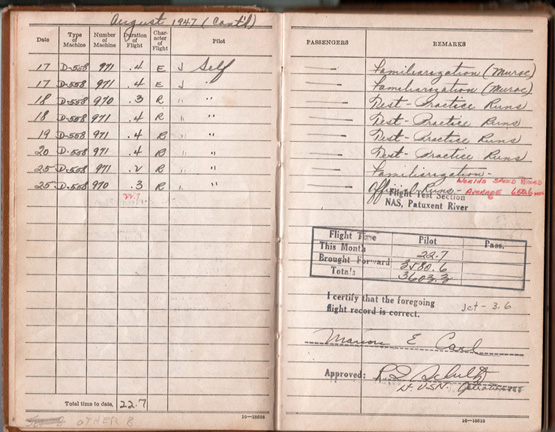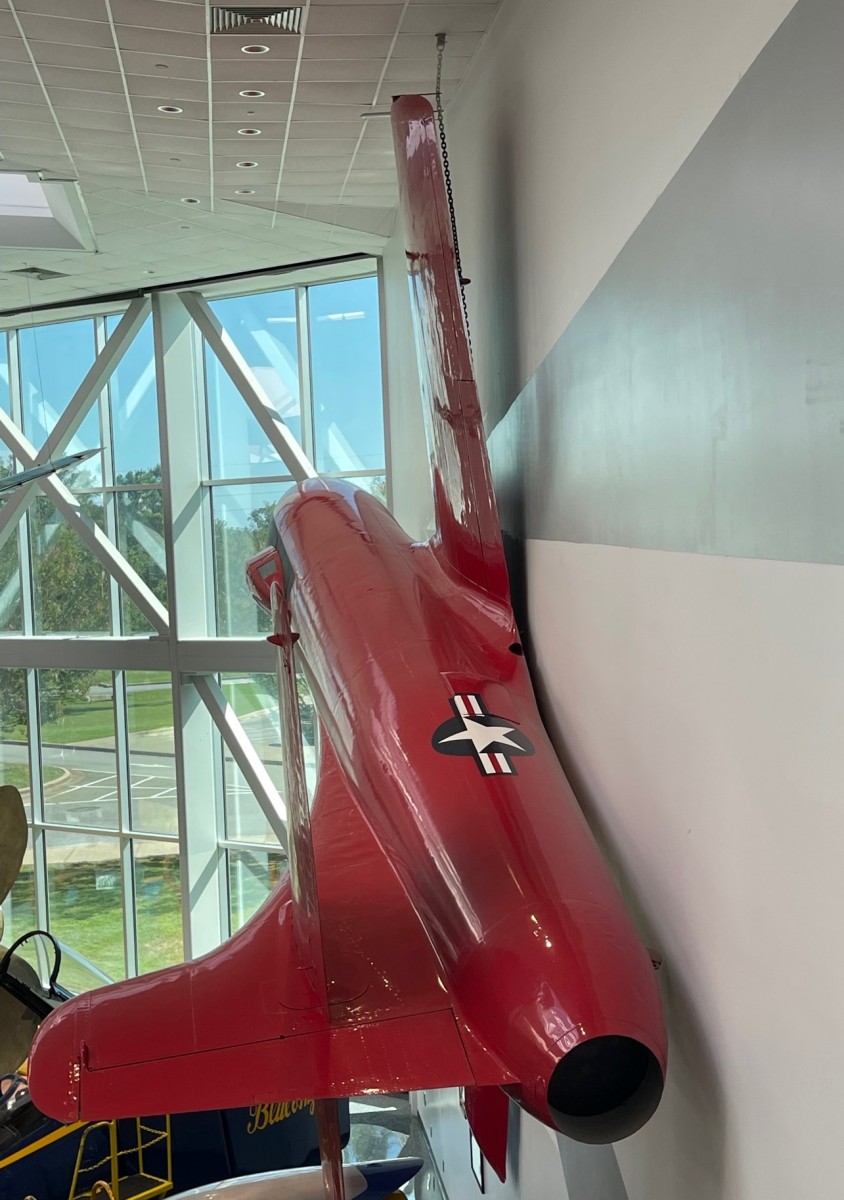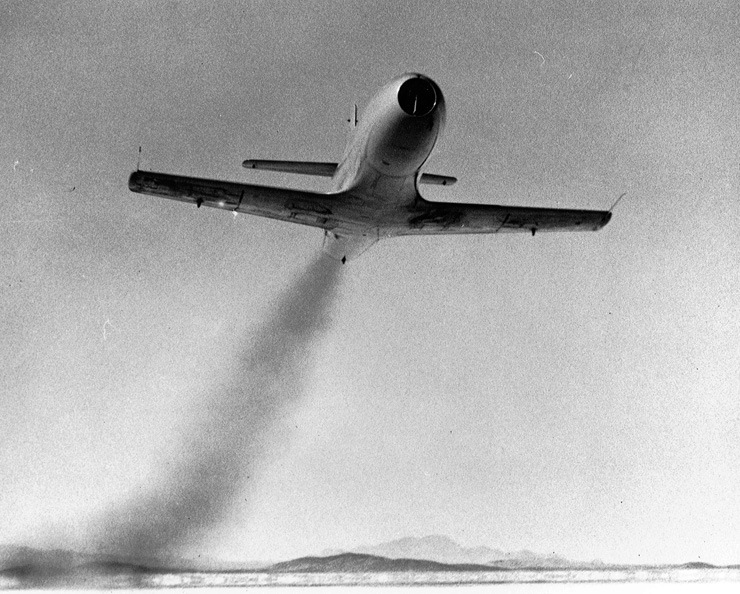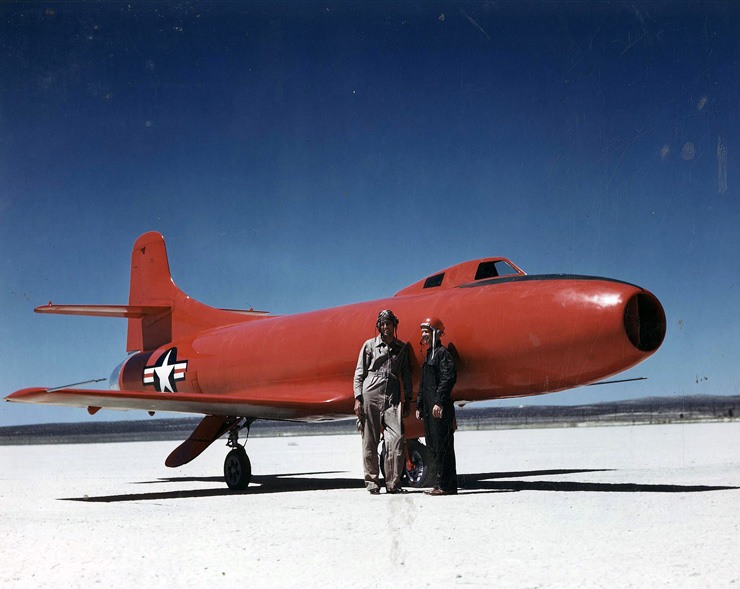Feature Aircraft: The "Crimson Test Tube"
The D-558-1 Skystreak, in its unique color and manner of display, is an eye-catcher in the museum. Here are some of the questions we are frequently asked about the airplane.
When did the D-558-1 make its first flight?
Douglas Aircraft Company test pilot Eugene May made the maiden flight of the airplane on April 15, 1947.
Did the D-558-1 break the sound barrier?
The immediate post-World War II effort to research high-speed flight focused the Navy’s efforts on subsonic flight and tasked the Army Air Forces with exploring supersonic speeds. Therefore, the Skystreak was not designed to break the speed of sound (approximately 770 M.P.H. at sea level)
Who flew the D-558-1?
A number of test pilots flew the airplane during its service between 1947 and 1953. The most famous flights were made by Navy CDR Turner F. Caldwell, who set a speed record of 640.743 M.P.H. on August 20, 1947, and Marine LtCol Marion Carl, who broke that record five days later with a speed of 650.6 M.P.H.
Why was it not painted in Navy colors?
It was thought that the scarlet color would improve visibility and make the airplane easier to see during testing. Because of this and the cylindrical shape of the fuselage, the press called it the “Crimson Test Tube.” The color made it more difficult to spot and the D-558-1s were subsequently painted white.
When did the museum acquire the airplane?
In 1964, the year after the museum opened, the D-558-1 became part of the collection. It is one of three built and was the airplane in which CDR Caldwell established the speed record on August 20, 1947. It made a total of 101 flights.
From the Archives
For aviators, the flight logbook is akin to a flying diary, documenting their flying lives from the specific aircraft flown to the types of mission logged. Personal notations add a flavor unique to a particular individual and in the case of these pages from the logbook of LtCol Marion Carl, USMC, document history. These entries for August 1947, during which Carl was assigned to the Naval Air Test Center at NAS Patuxent River, MD, note flights in the D-558-1 Skystreak leading up to his setting a speed record on August 25, 1947.

The August 1947, entries made in the flight log book of Lieutenant Colonel Marion Carl, USMC, include the one noting his record-setting flight in the D-558-1 Skystreak.
Featured Artifact
Corresponding with the Golden Age of aviation in the years following World War I, air races were extremely popular attractions for the airplane-crazed public. They could see acclaimed aviators like Roscoe Turner and Jimmy Doolittle and the nation’s fastest aircraft engaging in thrilling maneuvers. Among the most popular events was the National Air Races in Cleveland, Ohio, which remained popular after World War II. In 1947, the event featured pioneer female aviator Jackie Cochran, a performance by the Blue Angels and flights by the U.S. military’s newest jets. Although CDR Turner Caldwell did not fly at event, he received the Weatherhead Award for his record flight in the D-558-1 Skystreak.

One of the accolades Commander Turner F. Caldwell received for his record-setting speed run in the D-558-1 Skystreak was the Weatherhead Award, which through the generosity of his family is now displayed in the museum next to the aircraft he once flew.
Donate an Artifact
For archival donations (Documents, Books, Photographs, Scrapbooks, Manuals, Audio/Visual Film) email Jared Galloway at jared.galloway@navy.mil.
For artifact donations (Uniforms, Artwork, Weapons, Medals, Aircraft, Miscellaneous) email Dina Linn at dina.linn@navy.mil.


